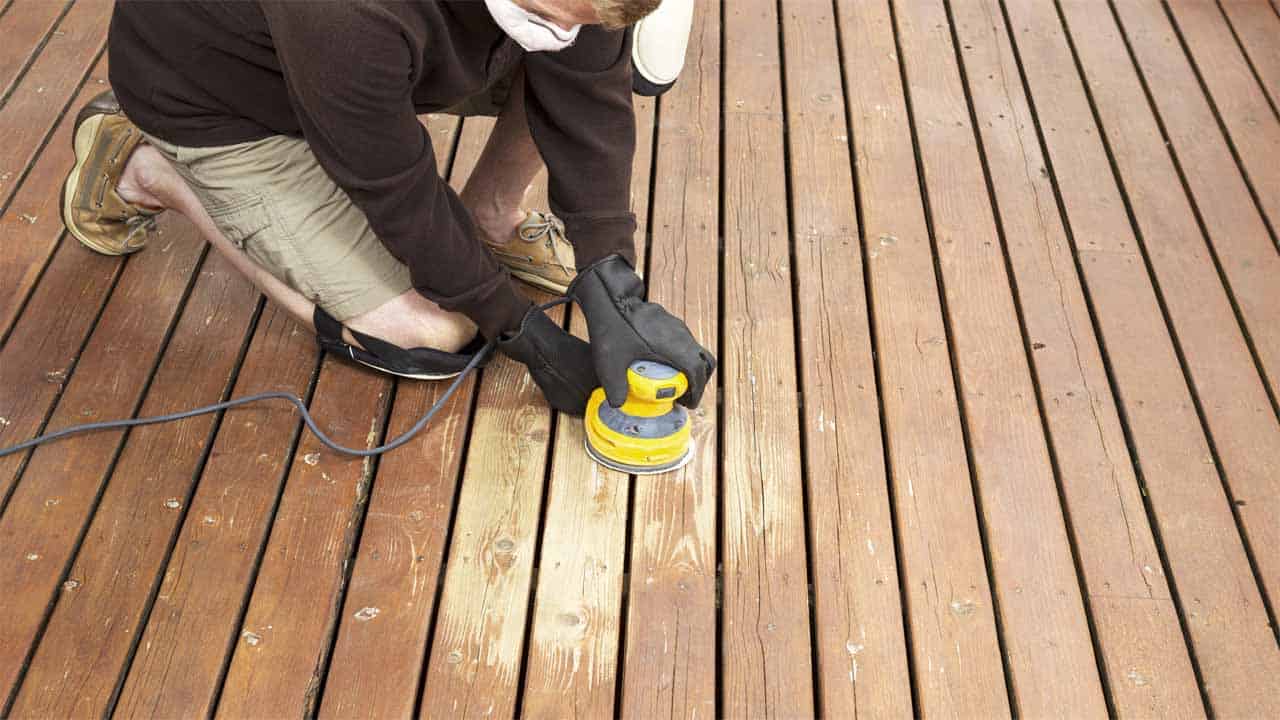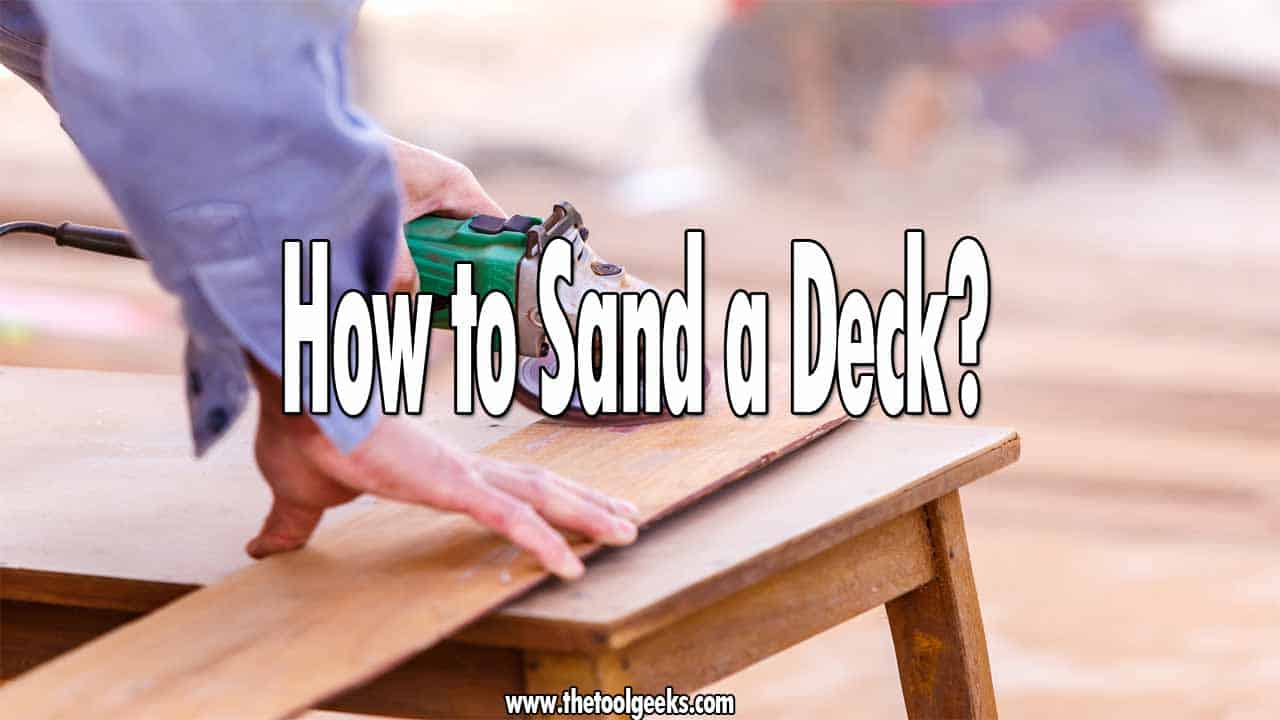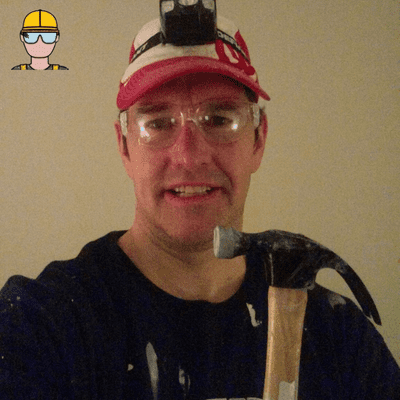How to Sand a Deck (By Hand & Using a Sander)
TheToolGeeks.com is a participant in the Amazon Services LLC Associates Program and other affiliate advertising programs. We may earn from qualifying purchases. (Learn More).
Regardless of how well you install, finish, and maintain your deck, the deck will still fade over time as a result of constant use and harsh weather.
The effects of the sun, rain, and even snow will strain the finish on the deck causing the deck to look worn out, bleached, and unsightly. This means you need to refinish the deck to revive its original look. But before you can finish the deck, you need to sand the deck first.
Sanding helps to improve the finish on the deck. Sanding a deck helps to prep the deck for painting by removing the old finish on the deck. It also helps to even out the grain in the wood and to increase adhesion, so the new finish can stick on the deck properly.
So, how to sand a deck? You need to prep the deck and then use a sander and the right sandpaper to sand the deck. But that’s not all.
How do you prep the deck for sanding? What do you need to sand a deck? You see there is more to know about sanding a deck and this post will identify and explain all you need to know about the topic. So let’s get on with it.
There are two ways to sand a deck. You can either:
- Sand by hand or,
- Use a sander.
Both methods are great and depending on your experience with sanding, you should get the same result regardless of the method you use. However, both methods are a bit different in their application. Let’s see why.
Related Read — Best Sander For Decks
How to Sand a Deck (by Hand)
Sanding a deck by hand is the same thing as sanding manually. This means you will sand the deck without using a sander or any other power tool.
For this method, you will need:
- Sandpaper: The sandpaper needed for your deck depends on the condition of the deck and how much sanding you want to do. If you have a very rough deck or you want to sand deep into the wood, then you will need coarse sandpaper. Any sandpaper below 80-grit is considered coarse.
If your deck isn’t that rough or you just want to sand lightly, then you will need medium-grit sandpaper. Any sandpaper between 80-grit and 120-grit is considered medium-grit sandpaper.
Regardless of the sandpaper you get, you still need to buy fine-grit sandpaper to give the deck a smooth and clean surface.
Any sandpaper from 150-grit and above is considered fine-grit sandpaper. Some sandpapers like the 240-grit are considered very fine sandpaper, and you will most likely not need those for sanding a deck.
- A pair of gloves: To protect your hands from injuries and to make sanding easier.
- Face mask or respirator: Sanding spews a lot of dust into the air. You will need a respirator to stop the dust from entering your lungs.
- A pair of goggles: This is to protect your eyes from dust.
- A brick or a small piece of wood: This is optional. Some people prefer to sand by wrapping the sandpaper around an object. The reason for this is to leave as much space as possible between your palms and the deck. This makes sanding easier and also prevents bruises.
- A paint stripper: This is also optional and is only advised if you have stubborn paint or finish on the deck that you want to strip. Paint strippers are rarely used on decks because sanding will remove the old finish.
- Kneepads
To sand by hand,
Start by Putting on Your Safety Gear
Your safety gear is anything and everything that will prevent injuries. These include your pair of gloves, a face mask or respirator, a pair of goggles, kneepads, and the likes.
Inspect the Deck and Make Repairs
Usually, decks especially old decks will be riddled with splinters, dents, cracks, protruding nails, screws, and the likes. These objects will make sanding very difficult. Not to mention the fact that nails, splinters, and screws can hurt you. If you notice any protruding nail, screw, or you have cracks and holes in the deck, then you need to make the necessary repairs.
Sometimes, a part of the deck might have been too damaged for repairs. Probably the wood is too old, weak, or discolored to be repaired. If you notice any part of your deck is too damaged or old to be repaired, you should have your carpenter replace that part with new wood.
Wash or Clean the Deck
Depending on how dirty the deck is, you will either wash or just clean the deck. Decks are usually very dirty and packed with grime, dust, mud, and sometimes algae. If the deck is not that dirty which I highly doubt, then you can use a mop and water to clean the surface of the deck to get rid of the dirt. The deck should get dry between 6 and 12 hours after cleaning.
However, if the deck is very dirty which is the case with most decks, then you need to wash (or power wash) the deck. To wash the deck, you will need a hose, detergent, or a deck-cleaning solution, and a soft brush. Start by spraying the deck with water from the hose. The first spray is to get rid of debris, waste, and grime on the deck.
After spraying with water, add a bit of detergent to a bucket of water. Then use the soapy water and a soft brush to scrub the deck. This will get rid of any other dirt or stain on the deck. After scrubbing the deck, spray it with water to rinse and then leave the deck to dry.
It takes a day or two for the deck o be dry enough for sanding. This means you can’t sand the same day you wash the deck.
Related Read — Best Wood Pallet Sanders
Pick the Right Sandpaper
We all know sanding a deck involves rubbing sandpaper against the wood but you need to start with the right sandpaper. The sandpaper you pick depends on how rough the deck is. By just looking at the deck, you can tell if you are dealing with a very rough deck or not.
For a very rough deck, you should start with coarse sandpaper like the 60-grit sandpaper. After sanding with the coarse sandpaper, you can move to the medium grit sandpaper like the 120-grit sandpaper and finish off with fine-grit sandpaper like the 180-grit sandpaper.
For a smooth or moderately rough deck, you can start with the medium grit sandpaper and move on to the fine-grit sandpaper later. Starting with the right sandpaper is key as it determines the type of finish you will get.
Now that you know the sandpaper to start with, let’s move to the next step.
Sand the Deck
After picking the sandpaper to start with, you can start sanding the deck. Since you are sanding by hand, you can wrap the sandpaper around a brick or a piece of wood.
This will make sanding easier and safer. Alternatively, you can fold the sandpaper and sand with that. Just ensure to expose the abrasive side of the sandpaper as that is the part that does the sanding.
To sand, rub the sandpaper against the wood repeatedly in a circular motion. Always keep track of where you have sanded so you don’t over-sand and damage the deck.
Get Rid of the Dust
As stated earlier, sanding produces a lot of dust. After sanding, you should use a vacuum or a soft brush to get rid of the dust on the deck. When you are done with this, you can go ahead to apply the finish you want on the deck.
How to Sand a Deck With a Sander?
Sanding with a sander is quicker and easier than sanding by hand. This is because you will be using a power tool on the deck rather than using your hands.

For this method, you will need:
- A sander
- Sanding discs or sandpaper
- Rags
- Safety gear (this includes a pair of gloves, breathing protection, knee pads, and a pair of goggles).
- Rags
Prep the Deck
To sand with a sander, you need to follow the same preparatory steps as sanding by hand. The only difference with both methods is how you sand.
Start by putting on your safety gear. Then you should inspect the deck for damages, make the needed repairs, and clean or wash the deck. After doing all these, you can go ahead to prep the sander.
Prep the Sander
Unlike sanding by hand where you can just pick the sandpaper and start sanding, using a sander is a tad different. This is because you need to prep the sander. Prepping a sander involves cleaning the sander, inspecting the sander to be sure it’s in good condition to be used, attaching the right sandpaper or sanding disc, and powering the sander.
Use a clean rag to clean the sander. Then inspect it for any damages or worn-out parts. If the sander is in good condition, you can go ahead to attach the right sandpaper or sanding disc.
Attach the Sandpaper or Sanding Disc
Some Sanders use a sanding disc which is circular sandpaper while other Sanders use regular sandpaper. You should attach the right sandpaper or sanding disc to the sander.
Remember our rule for picking the right sandpaper. Start with coarse sandpaper for rough decks. Then work your way up to medium grit sandpaper and finish with fine-grit sandpaper.
For smooth or moderately rough decks, start with medium-grit sandpaper and finish with fine-grit sandpaper. After attaching the sandpaper or sanding disc correctly. You should power the sander.
Related Read — Can You Sand Drywall?
Power the Sander
There are two types of sanders when it comes to power. Corded sanders need to be plugged in a wall socket or outlet while cordless sanders are battery-powered. Cordless sanders are better for sanding decks because there is no restriction of movement.
You will need to move around the deck while sanding and this can be difficult with a corded sander because of the length of the cord. Battery-powered Sanders on the other hand are very mobile.
Start Sanding
After prepping the deck and the sander, you can sand the deck. Place the bottom of the sander on the deck. The sandpaper or sanding disc is usually attached to the bottom of the sander. Then press the trigger button to start sanding.
The trigger button is usually near the handle of the sander. You should hold the sander firmly while sanding because Sanders vibrates a lot. If you notice the sandpaper of the sanding disc you are using is worn out, you can replace it with a new disc or sandpaper.
When you achieve the desired sanding result, you can stop sanding.
Get Rid of the Dust
Use a vacuum or a soft brush to get rid of the dust after sanding. Then clean up and apply the finish later.
Now you know how to sand a deck by hand and with a sander but what sander should you use on your deck?
Should You Sand or Strip Your Deck?
You should sand the deck rather than strip it. Sanding and stripping are the two most common methods for removing the finish from a deck. Sanding involves rubbing sandpaper against the surface of the deck to remove the existing finish. Stripping on the other hand involves using active paint strippers to remove the existing finish on the deck. Both methods are great but which should you use?
When it comes to removing a finish from the deck, sanding is a better alternative to stripping. You have a better chance to remove the finish without damaging the wood when you sand as opposed to when you strip. Sanding a deck rarely results in damaged wood except in some cases where you lose control over the sander or you over-sand the wood.
Stripping on the other hand is a more complex process as there are specific instructions to follow. Stripping involves using either caustic paint strippers or solvent paint strippers to remove the existing finish. You are more likely to damage the wood with a paint stripper than with sanding.
Paint strippers penetrate more deeply into the wood than sanding and the wood used to make decks are usually softwood that can get gouged and discolored. So you are more likely to remove more than just the previous finish with a paint stripper if you are inexperienced.
Also, paint strippers are not exactly eco-friendly. The fumes from the paint stripper can be very toxic if inhaled and the compound shouldn’t come in contact with the skin too. Paint strippers are also a more expensive option than sanding. While stripping is a less rigorous method, it can be dangerous in the hands of a beginner. Sanding is a cheaper, safer, and effective alternative.
Related Read — How to Wet-Sand Epoxy Resin?
Pro Tips to Follow When Sanding a Deck
- Do not press on the sander. Though Sanders vibrates while being used, you should just keep the sander in position so it doesn’t vibrate out of place. If you press on the sander, you will damage the wood.
- Keep track of where you have sanded so you don’t over-sand the surface.
- Inspect the deck for protruding nails, screws, and splinters before sanding.
- Do not use aggressive sanders on a deck. This is because decks are usually made from softwood and these aggressive Sanders can gouge the softwood.
- Always ensure the deck is dry before you try to sand. If you power-washed the deck or rain fell recently. You should leave the deck for a few days to get dry before you try to sand.
So there you have it, if you have any questions or comments about the topic, please leave them below and I’ll attend to them as soon as possible. Have a great day.
Amazon and the Amazon logo are trademarks of Amazon.com, Inc, or its affiliates.

